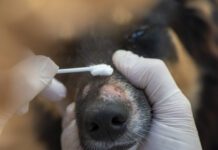[Updated December 18, 2018] Once again it is time to get on a plane and leave for another herb lecture. As always, Willow, my 12-year-old Shepherd cross, has figured out that I am leaving. Her big, brown, sad eyes melt my heart as I lie down on the floor with her to say goodbye. “I’m sorry, sweetie. It just isn’t practical to take dogs on business trips like this,” I tell her as I snuggle close and kiss her soft snout.

Immediately I am rewarded with a pardoning dog kiss. Right on the lips – and her breath is bad. Really bad. Kinda like rotting meat. Although Willow’s breath can be temporarily freshened by a few drops of a ginger-mint herbal tincture, the persistence of her bad breath suggests that it may be time for a periodontal checkup.
Signs of Periodontal Disease
– Foul breath – Yellow-brown tartar at gum line – Red, swollen, bleeding gums – Drooling – Blood in the saliva – Broken teeth – Reluctance or hesitation to chew bones or hard foods – Loss of appetite Chronic bad breath is not a normal, healthy condition. Even though it is true that dogs will sometimes eat UFOs (Unidentifiable Fetid Objects), unpleasant things collected from unspeakable sources that can make their mouths smell unbearable for short periods of time, their breath should never remain foul. And while hal-itosis (bad breath) is sometimes caused by indigestion or other imbalances deeper in the digestive tract, it is more commonly attributable to plaque; a buildup of anaerobic bacteria on the teeth and gum tissues. If left unchecked, the plaque will become mineralized, forming hard tartar that will serve as a breeding ground for even more bacteria. Eventually the gums may become infected, causing gingivitis. Even worse, an infection in one or more tooth sockets (periodontitis) may occur, which, if left untreated, can spread to the kidneys, heart valves, or other vital organs. Willow’s halitosis is not uncommon. According to the American Veterinary Dental Society (AVDS), 80 percent of dogs will develop some form of periodontal disease by age three. That’s an astounding figure, especially when we consider that most dogs in North America eat commercial kibble – which, according to most manufacturers, “cleans the teeth and promotes healthy gums.” Why then, does the AVDS insist that we have our pets’ teeth cleaned at least once, preferably twice, per year? The answer to this question might be answered next time you turn on the television or open a magazine to view images of wild carnivores eating a carcass. Snarling, flesh eating wolves, coyotes, and wild cats bearing needle-sharp, glistening white, perfect teeth and healthy pink gums. These animals do not eat kibble. Nor must they endure anesthesia to have their teeth cleaned. Obviously, they eat foods that support dental health. Dental hygiene is maintained in animals much the same way it is with humans – by cleaning the teeth regularly. Much of this is accomplished when dogs eat the food types their bodies require: Raw bones, high quality meat, and foods that are rich with the enzymes and probiotics (beneficial bacteria) that are necessary to maintain a healthy “working environment” in a dog’s mouth.
Raw, Meaty Bones for Dental Health
Although many kibble foods are quite hard, all break down into soft particles when chewed or dissolved in the mouth. In terms of cleaning and strengthening teeth and gums, none can replace raw, meaty bones. Bones contribute calcium that is necessary for building strong teeth and bone tissue. They also provide the perfect natural chewing medium for keeping your dog’s teeth and gums clean and healthy. But that’s not all – raw bones also offer nutritional elements that heat-prepared commercial foods cannot – live probiotic bacteria and natural enzymes that are needed to maintain healthy populations of bacterial flora in the mouth. In essence, this oral flora of “good guy” bacteria fight and kill harmful bacteria such as Streptococci, Actinomyces, and other pathogens before they can multiply and cause gingivitis or other infections. A healthy flora also helps with the breakdown and removal of food particles that remain lodged between the teeth after each meal. The beneficial bacteria in your pet’s mouth also produce the chemistries needed to maintain pH (acidity) balances in the mouth. This makes for a less favorable environment for the reproduction of harmful microbes. Regardless of whether you are feeding a raw diet, canned food, or kibble, consider feeding your dog a raw bone each week – it will work wonders toward keeping his teeth clean and his oral environment in balance. In addition, feeding fibrous vegetables such as unpeeled organic carrots, broccoli, or celery (at mealtime or as snacks) can serve as natural, probiotic, enzyme-rich flosses. Leafy green vegetables and kitchen fresh herbs (parsley, dill, etc.) can also be mixed with the food, to contribute antioxidant, breath freshening chlorophyll. It is also wise to add a good digestive enzyme powder and a probiotic supplement (acidophilus, bifidus, etc.) to each meal, as these measures will greatly help with the maintenance of healthy bacteria and pH levels in the mouth. Animal Essentials, Dr. Goodpet, PetGuard, and Prozyme are among my favorite brands.
Brushing a Dog’s Teeth
If your companion eats a well-balanced natural diet all the time, she will likely have strong, clean teeth and gums throughout her life, even without brushing. An occasional brushing is a good idea anyway, even if her teeth and gums appear perfectly healthy. If your pet does not eat raw foods or bones on a regular basis, plan on brushing at least once a month. If her teeth appear yellow and prone to plaque, then brushing should occur at least weekly. Have your veterinarian examine your companion’s teeth at least twice a year. Toothbrushing is not a veterinary procedure; you can do it yourself. Honest! The process begins by choosing a toothpaste that is made specifically for use in pets. There are dozens in the marketplace – find one that you think your companion would enjoy eating. Do not use toothpaste that is made for humans, as many contain foaming agents that can cause stomach upset in animals. Use a brush that is designed specifically for dogs, as these brushes are specially angled and have a longer reach for use around sharp teeth and long jaws. Start by brushing the outer surfaces of just one or two teeth per session, concentrating on the upper portions of each tooth and along the gum lines where tartar typically collects. Don’t worry too much about the inner (the tongue side) of your pet’s teeth. These surfaces are well protected by the saliva and oral flora, and are much less likely to develop tartar. After your pet is accustomed to having a couple of teeth brushed each week, start increasing the number of teeth cleaned at each session. The idea is to make him feel comfortable, non-threatened, and looking forward to his next cleaning.
Herbal Remedies for Dental Health
A variety of herbal products are available for prevention or even treatment of minor cases of gingivitis in dogs and cats. Some are also useful for animals that flatly prohibit brushing. Most of these products come in liquid forms that can be sprayed or wiped onto the outer gums and tooth surfaces. Virtually all are strongly antibacterial, and are especially useful in circumstances where bad breath, slightly reddened gums, and plaque formation serve as telltale signs of an early-stage infection. Among my favorite herbs for knocking down early onset gingivitis are myrrh (Commiphora molmol), thyme (Thymus spp.), and fennel seed (Foeniculum vulgare) extracts, as all have well-documented antibacterial and tartar-fighting activities. I also use goldenseal (Hydrastis canadensis) extract, which helps reduce gum inflammation as it knocks down infection.
Disinfectant Herbal Gum Formula
Combine the following herbal tinctures: 1 part myrrh tincture; 1 part fennel tincture; 1 part thyme tincture; 1 part goldenseal tincture. With a clean cotton or foam swab, wipe this mixture across the outer (lip side) surfaces of your dog’s teeth and gums once or twice daily. Antibacterial products intended for mixing into an animal’s drinking water should only be used if there is an infection behind the teeth (tongue, inner gums, throat, etc.). This is because some of the strong antibacterial herbs and other ingredients in these products may not discriminate between good and harmful types of bacteria; they might reduce flora populations that are needed for a balanced, disease-resistant oral environment. For freshening breath and improving digestion, I like using a combination of ginger root, parsley leaf, peppermint, fennel, and chamomile. This formula, although not as strongly antibacterial as the one previously mentioned, will help maintain healthy balances in the mouth – and relieve flatulence, too!
Herbal Fresh Breath & Tummy Formula
Combine the following: 2 tbsp. dried parsley; 1 tbsp. dried peppermint; 1 tbsp. ground fennel seed; 1 tbsp. dried chamomile; 1 tsp. minced, fresh ginger root. Bring 16 ounces of water to a boil in a glass or stainless pot. Add all of the above ingredients, stir well, and reduce to a low simmer for 15 minutes. Allow to cool, then strain and press through a mesh sieve. To use, draw a small amount (10-20 drops) into a squeeze dropper and squirt directly into your companion’s mouth. If needed, add 1-2 tbsp. of honey to the completed 16 ounces of formula to improve palatability. Get more ideas for freshening your dog’s breath and improving her dental health at Dogster.com.
DOG HALITOSIS: OVERVIEW
1. Feed raw bones at least once a week, to help clean your companion’s teeth. 2. Add probiotic and digestive enzyme supplements at each meal. 3. Brush your dog’s teeth, and take him to the vet for a dental checkup at least once a year. 4. Learn the signs of periodontal disease, and check your dog’s mouth at least once a week. Greg Tilford serves as a consultant and formulator to holistic veterinarians throughout the world, and is CEO of Animal’s Apawthecary, a company that develops herbal products specifically for use in animals. Tilford is also author of four books on herbal medicine, including All You Ever Wanted to Know About Herbs for Pets, co-authored with his wife, Mary.






